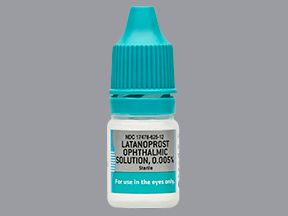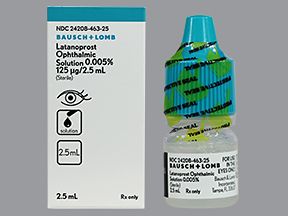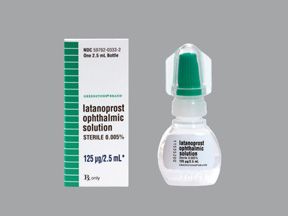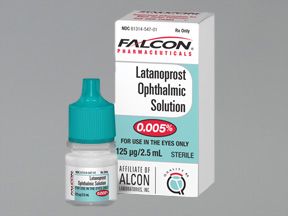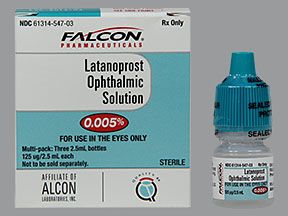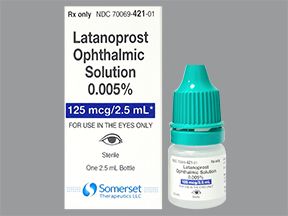Key takeaways
- Latanoprost eye drops are used to treat open-angle glaucoma and ocular hypertension. These conditions are characterized by high pressure inside the eye and may cause permanent vision loss.
- Latanoprost is a generic drug. Latanoprost eye drops are also available in brand-name versions (Xalatan and Iyuzeh).
- Side effects of latanoprost eye drops include eye color changes and darkening or discoloration of skin around the eye. These effects typically occur slowly and may be permanent.
Latanoprost (lah-TAN-oh-prost) is a prescription eye drop medication that’s used to treat open-angle glaucoma and ocular hypertension. It’s sometimes called an ophthalmic solution, meaning it’s a liquid that is applied to the eye.
Latanoprost is a generic drug. Brand-name versions of latanoprost include Xalatan (ZA-luh-tan) and Iyuzeh (eye-YOO-zeh). Generic drugs usually cost less than brand-name versions of the drug.
Open-angle glaucoma and ocular hypertension are conditions where the pressure inside the eye, called the intraocular pressure (IOP), is too high. This can lead to eye damage and permanent vision loss.
Eye pressure is determined by the rate at which a clear fluid (called the aqueous) is produced inside the eye and drains from the eye.
Latanoprost works by increasing the outflow of aqueous from the eye. This lowers eye pressure, decreasing the risk of IOP-induced eye problems and vision loss.
Latanoprost comes as an ophthalmic solution with a strength of 0.005%.
The typical dosage of latanoprost eye drops is 1 drop per day in the affected eye(s).
Your doctor will recommend the dosing of latanoprost that’s right for you.
Like most drugs, latanoprost may cause side effects. The following lists don’t include all possible latanoprost side effects.
According to its prescribing information, more common side effects of latanoprost that occurred in studies include:
- foreign body sensation (feeling something is “in” your eye)
- punctate keratitis (irritation and inflammation of the cornea)
- stinging
- eye redness
- blurry vision
- itching
- burning
- darkening of eye color
Other latanoprost side effects include:
- excessive tearing
- eyelid discomfort/pain
- dry eye
- eye pain
- eyelid margin crusting
- reddening of the eyelids
- sensitivity to light
- changes in the thickness, length, or color of the eyelashes
- darkening of the skin around the eyes
Serious side effects from latanoprost can occur, but they aren’t common. If you have serious side effects from latanoprost, call your doctor right away. But if you think you’re having a medical emergency, you should call 911 or your local emergency number.
Allergic reactionFor some people, latanoprost eye drops can cause an allergic reaction.
In general, symptoms of an allergic reaction can be mild or serious.
What might help
If you have mild symptoms of an allergic reaction, such as a mild rash, call your doctor right away. They may suggest a treatment to manage your symptoms and can determine whether you should keep using latanoprost eye drops.
If you have symptoms of a severe allergic reaction, such as swelling or difficulty breathing, call 911 or your local emergency number right away. These symptoms could be life threatening and require immediate medical care.
If your doctor confirms you’ve had a serious allergic reaction to latanoprost, they may have you switch to a different treatment.
The following is important information you should consider before using latanoprost eye drops.
- Contact lenses: If you wear contacts, remove them before applying latanoprost eye drops. Wait at least 15 minutes after using latanoprost before putting your contact lenses back on.
- Other eye drops: If you use other eye drops in addition to latanoprost, do not apply them to your eyes at the same time. Wait at least 5 minutes between applications.
- Darkening of your eyes and lashes: Latanoprost can darken the color of your eye or change it from a light color to brown. It can also cause the skin around your eye to darken. It may cause your eyelashes to grow longer, thicker, and darker in color. These changes often occur slowly, but they can be permanent. If you only use this drug in one eye, your eyes may look different from each other. Call your doctor if you have these changes.
- Contamination of dropper tip and solution: Be careful not to let the dropper tip of the eye drops touch your eye, eyelids, or anything else when giving yourself the medication. This could contaminate the dropper tip and the solution and lead to an eye infection.
- Exposure to extreme temperatures: Do not store latanoprost eye drops in your car’s glove compartment or leave the bottle in your vehicle. Exposure to extreme temperatures can damage this medication or make it less effective.
- Herpes keratitis: Reactivation of herpes keratitis eye infections (“eye herpes“) has been reported during treatment with latanoprost eye drops. Be sure to tell your doctor if you have active eye herpes or a history of herpes keratitis infections before you begin using latanoprost eye drops.
- Macular edema: In rare cases, use of latanoprost may cause macular edema, an eye condition that can cause permanent vision problems. You’re at higher risk of this side effect if you have a history of macular edema or other eye problems. Talk with your doctor before using latanoprost if you have a history of eye problems.
How should I take latanoprost?
Apply 1 drop of latanoprost per affected eye(s) per day, preferably in the evening.
What if I miss a dose?
If you forget to take a dose of latanoprost eye drops, continue with the next dose at your usual time of day. Do not “double up” drops of latanoprost to make up for a skipped dose.
How should latanoprost be stored?
Store unopened bottles of latanoprost eye drops in the refrigerator, at a temperature range of 36°F to 46°F (2°C to 8°C).
After you begin using a bottle, you can store it at room temperature (up to 77°F or 25°C) for up to 6 weeks.
Disclaimer: Healthline has made every effort to make certain that all information is factually correct, comprehensive, and up to date. However, this article should not be used as a substitute for the knowledge and expertise of a licensed healthcare professional. You should always consult your doctor or another healthcare professional before taking any medication. The drug information contained herein is subject to change and is not intended to cover all possible uses, directions, precautions, warnings, drug interactions, allergic reactions, or adverse effects. The absence of warnings or other information for a given drug does not indicate that the drug or drug combination is safe, effective, or appropriate for all patients or all specific uses.





